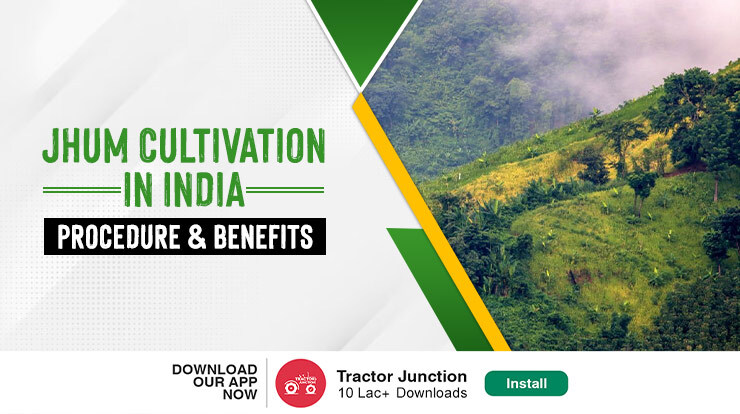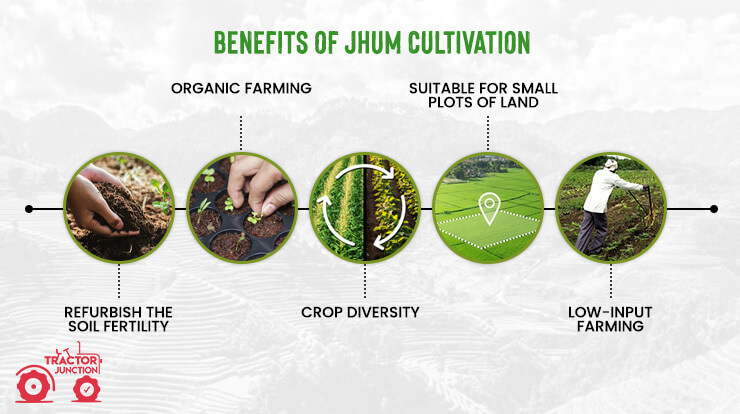
Jhum Cultivation is one of the oldest farming methods practiced in the northeastern regions of India and hilly areas of Bangladesh. It is beneficial for the environment as it prevents the growth of weeds on agricultural land and also plays a significant function in soil pest control. Jhum cultivation also known as Pamlou, Khi, and Kumara in various regions of India. So, explore this blog to learn more about Jhum cultivation, its benefits, and its steps.
Overview of Jhum Cultivation
The Jhum Cultivation involves clearing trees or other vegetation from land, burning and cultivating it for a specific period. The other name of Jhum cultivation is shifting
Cultivation, Slash and Burn Cultivation
- The farmers involved in this process of Jhum cultivation are known as Jhumias.
- Jhum Cultivation also known as the burn or slash method of cultivation.
- The farmers also burn plant ash for farming or cow grazing.
- Jhum Cultivation also creates fertile soil for cultivation.
- Additionally, this system is ideal for fragile ecosystems and harsh environmental conditions of the tropics.
- And that is why we have only limited success in finding viable alternatives to shifting agriculture in India.
- In Jhum cultivation, farmers grow crops for their own families. Sometimes they trade, barter or sell food for cash in nearby markets.

Benefits of Jhum Cultivation
- The first and most important benefit of Jhum cultivation is that it helps soil to retain all nutrients lost during agricultural processes. Due to the recycling process, the growth of natural vegetation enhances, which is a basic earth need. This technique is extremely sustainable, which we need in today’s world of diminishing resources.
- Shift cultivation or shift cultivation also promotes organic farming benefits. Such as natural vegetation that has been burned and converted into ash acts as a natural fertilizer and gives nutrients to the crops
- Additionally, shift cultivation is an environmentally favourable method of farming. This farming has high efficiency because it can increase production on a small scale.
- Jhum cultivation inhibits the growth of weeds on agricultural land, which are otherwise worthless greens that grow everywhere and consume nutrients.
- Because the soil recycled regularly, many soil-borne illnesses that might develop over time are eradicated, considerably minimizing the danger of such diseases.

Jhum Cultivation Process
Jhum Cultivation or Shift Cultivation is a type of farming where farmers clear the land by temporarily removing shrubs, trees, and bushes between March and June. Once the trees cleaned, they burn out the vegetation before monsoon. After completing this process, farmers leave that land for 10-20 years to regrow the plant. Move to a different place for the cultivation process. Soil fertility supposed to be replenished during this fallow period.
Jhum Cultivation widely practised in hilly areas of the North Eastern Region. This farming also performed in Sikkim, Bihar, Orissa, Tamil Nadu, Kerala, Maharashtra, Andhra Pradesh, and Madhya Pradesh.

Top 3 Cultivators Suitable for Jhum Farming in India
1. Mahindra Cultivator
- It saves time and offers precision.
- It is simple to operate and quick to adjust.
- Especially useful for paddy cultivation
2. Universal Heavy-Duty Rigid Cultivator
- It has 30-55 Implement Power that provides fuel-efficient work.
- It includes a 72×6 sq: tube & 65×6 angle center support of frame size.
- Ideal option for complementing a range of farming implements.
3. Soil Master CT-1100 (8.5 Feet)
- It has 50 Hp and above implement power.
- Soil master Cultivator CT-1100 used for deep ploughing in root-infested, sticky, stony, and laborious soils.
- It also used for deep ploughing in root-infested, sticky, stony, and laborious soils.
Alternative Farming Methods For Shifting Cultivation
Jhum cultivation has been a traditional agricultural system for centuries. However, it has been found that some negative impacts are also occurring on the environment from Jhum cultivation. Therefore, to prevent this, some alternative farming methods have been developed, which mentioned below:
- Agroforestry: This farming method joins trees and crops on similar land. It is also an alternative to jhum cultivation because it promotes biodiversity, crop productivity, and soil fertility.
- Improved production systems: This technique employs better crop varieties, fertilisers, and other inputs to boost yield and decrease the need for shifting cultivation. It mostly used for subsistence farming in tropical highland areas.
- Pineapple agroforestry: This alternative involves growing pineapples through an agroforestry system, which will reduce the need for shifting cultivation.
- Intercropping diversification: Intercropping diversification refers to growing multiple crops on the same land. This method also helps to boost yield and eliminate the need for shifting cultivation.
- Tree retention: Tree retention is used by farmers who use slash-and-burn farming to control weed growth. Retaining trees on the property can assist in preserving soil fertility and minimize the need for shifting agriculture.
5 Major Crops You Can Grow Through Shift Cultivation
The crops typically grow through jhum cultivation are as follows:
| Food Grains | Vegetables | Cash Crops |
|---|---|---|
| Rice | Cucumber | Cotton |
| Maize | Pumpkin | Ginger |
| Millet | Melon | Linseed |
| Job’s Tears | Stringbean | Rapeseeds |
| Small Millets | Soya-Bean | Sesamum |
Farmers opt mixed cropping where they grow food grains, vegetables, and cash crops, and the choice of crop consumption-oriented.
Jhum Cultivation in Mizoram
Mizoram is an area in India where Jhum cultivation has long been practiced. Mizoram is a hilly state located in the northeastern part of India. It is also the land of Mizos and shared by seven sisters. The major recognized tribes of Mizoram are Lushei, Ralte, Hmar, and Pawi.

Final Words
Jhum farming, also known as shifting cultivation, an effective resource-based subsistence agricultural technique. It entails cleaning patches of forest in the mountains, letting them dry for a month and then burning it. Hence, Jhum cultivation includes harvesting, ensuring food security and providing the necessary variety for nutrition and food preferences.
Frequently Asked Questions on Jhum Cultivation
Que. What is Jhum cultivation?
Ans. Jhum Cultivation involves cutting down the trees and vegetation on land to make fertile soil for farming.
Que. Which state practices Jhum cultivation most in India?
Ans. Mizoram practices Jhum cultivation most in India. It uses more than 50% of the area for jhum cultivation.
Que. What is the season of Jhum cultivation?
Ans. In January, the hummus clears the forest and dry the woods. The dried material then burned in March or April to make it suitable for jhum cultivation.
Que. What is the duration of Jhum farming?
Ans. Jhum cultivation takes around 10- 20 years. But now, due to population growth in many locations, this time frame has been shortened to 2–5 years.
Que. What type of farming is Jhum cultivation?
Ans. Jhum cultivation is a traditional agricultural type of farming. It also involves burning vegetation on the land before farming it for a specific period.
Que. Which tribes practice Jhum cultivation in India?
Ans. The Jummas tribes practice Jhum cultivation in India. They created this agricultural method to suit the rugged, hilly landscape in which they lived.
Que. Which are the other countries that do Jhum cultivation?
Ans. After India, Bangladesh, Mexico, Central Africa, Central America, and South-East Asia do Jhum cultivation.
Related Post
Guide to Jackfruit Farming – Steps, Costs & Profits to Expect
Aquaponic Farming In India: A Guide Towards Sustainability

